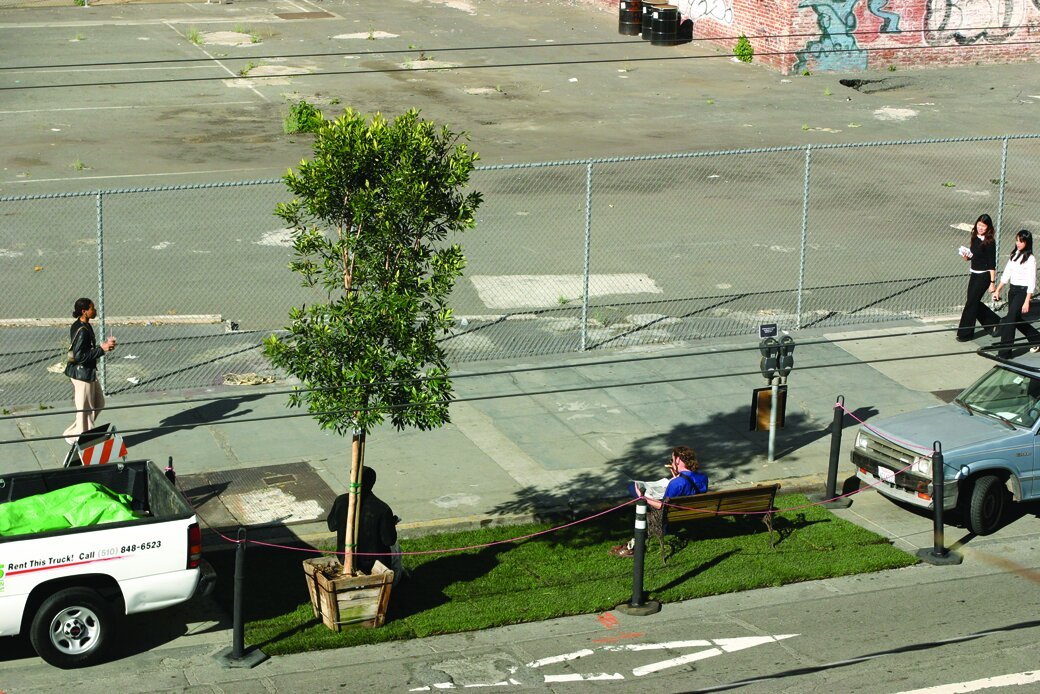Park(ing) Day is 17!
September 15, 2023 is the 17th year of Park(ing) Day, the annual global event where people transform curb lane parking spots into public parks and social spaces to demonstrate and advocate for safer, greener, and more playful streets for people.
The original Park(ing) installation at 1st and Mission in San Francisco, 2005. Image Credit: Rebar
Park(ing) Day started as a guerrilla art installation in a single metered parking space in downtown San Francisco in 2005. Inspired by a long legacy of artists, designers, and activists such as Jaime Lerner, Bonnie Ora Sherk, and Gordon Matta-Clarke, my colleagues and I at Rebar temporarily opened a downtown parking spot as a space for people, then shared the idea through a how-to-manual that resulted in the idea becoming a global phenomenon in partnership with thousands of volunteer participants and help from organizations like TPL and ASLA.
Park(ing) Day Detroit, 2019
Park(ing) Day is part of the broader movement of tactical urbanism that utilizes quick, short term interventions to pilot longer-term strategic changes in the built environment. In the 17 years since Park(ing) Day’s inception there have been some significant gains and victories. For example, the transformation of New York City’s streets through public space and active mobility enhancements has laid the groundwork for congestion pricing - charging road users for the use of streets as a public resource. The opening of numerous inner city areas to people, such as Barcelona’s superblock system and Oslo’s car-free city center have resulted in significant reductions in air pollutants and an increase in pedestrian safety. Honestly, we at Rebar expected that by now, the utility of Park(ing) Day as a design activism tool would have subsided, superseded by more strategic, technocratic initiatives. However, this year’s Park(ing) Day is bigger and more necessary than ever.
Pedestrians walk along South Alvarado Street in downtown Los Angeles. Image Credit: Al Seib / Los Angeles Times via Getty Images file
Tragically, the US continues to experience significant traffic violence. U.S. traffic deaths hit a 20-year high in early 2022. The humble curb lane, already a contested space in 2005, has gained new players like ride-hailing vehicles and rented bikes and e-scooters. And in a pandemic that turbocharged the instant-delivery ecosystem, turned parking spaces into outdoor dining rooms, and upended long-held commuting patterns, the space beside the sidewalk has become increasingly coveted real estate. “The curb is extremely valuable public real estate,” says Professor and Author Donald Shoup. “It’s a huge mistake to give it away for free storage to private cars.” Pandemic-era street opening programs like Oakland’s Slow Streets provided a lifeline for urban communities, local businesses, and the service industry, while they have highlighted existing systematic inequalities. Traffic violence, air pollution, and unequal access to mobility choice continue to disproportionately affect immigrants, the poor, and people of color. While the passage of the The Bipartisan Infrastructure Law means an unprecedented opportunity to decarbonize transportation, passenger cars continue to be the main source of transportation-related emissions in the United States, accounting for 38 percent of the total in 2020.
And so, we will not stop our action and advocacy until there is an end to motordom, an end to auto-dependence in our urban areas, and there is true mobility choice for all! The work continues, carried on by an incredible coalition of design activists and guerilla bureaucrats such as Transform, East Oakland Collective, PHINCO, umverkehR, Better Block, PlacemakingX, Street Plans, Transportation Alternatives, Families for Safe Streets, and many, many others.
PRN’s map allows you to explore how much land is dedicated to parking in over 80 major cities
This year, we are pleased to announce a strategic alliance with the Parking Reform Network (PRN). Parking reform is the use of policies and activism to discourage the building of too much parking supply and encourage more equitable, efficient and sustainable parking management. PRN offers a number of practical tools to take your Park(ing) Day advocacy to the next level. Check out PRN’s amazing Parking Lot Map where you can explore how much land your city dedicates to parking. Are you ready to advocate for wiser use of parking space in your community? Then dive into PRN’s Parking Benefit District guide for activists.
Park(ing) Day Japan, 2020. Image Credit: parkingday.jp
We hope you are able to join us for this year’s Park(ing) Day event. If so, add your project to the global map and know that you are part of a growing group of people from all around the world taking action for safer, greener, more playful, and more equitable streets for people.






